University Report: CIPD Advanced Qualifications 7LTD Learning & Talent
VerifiedAdded on 2022/09/05
|16
|4497
|20
Report
AI Summary
This report critically analyzes and evaluates the formulation and implementation of learning and talent development (L&D) strategies, policies, and methods within the context of Heidrick & Struggles, a global executive search and leadership consulting firm. The analysis begins with an overview of L&D strategies and their importance for organizational success, including the impact of technological advancements and the need for continuous employee development. A PESTEL analysis is used to identify external environmental factors influencing the L&D strategy, considering political, economic, social, and technological aspects, particularly focusing on the impact of Brexit and the evolving workforce demographics. The report contrasts the 'Best Practices' and 'Best Fit' approaches to L&D, highlighting Heidrick & Struggles' adoption of the 'Best Fit' approach. This includes the use of performance reviews and individual coaching to tailor development opportunities. The report further evaluates the potential and appropriateness of various L&D strategies, policies, and methods, considering contextual factors specific to Heidrick Consulting. The challenges of integrating different consulting businesses with varying L&D approaches are discussed, and the transition towards a unified L&D team is explored. The report provides an in-depth analysis of the company's L&D strategy, its challenges, and future directions.
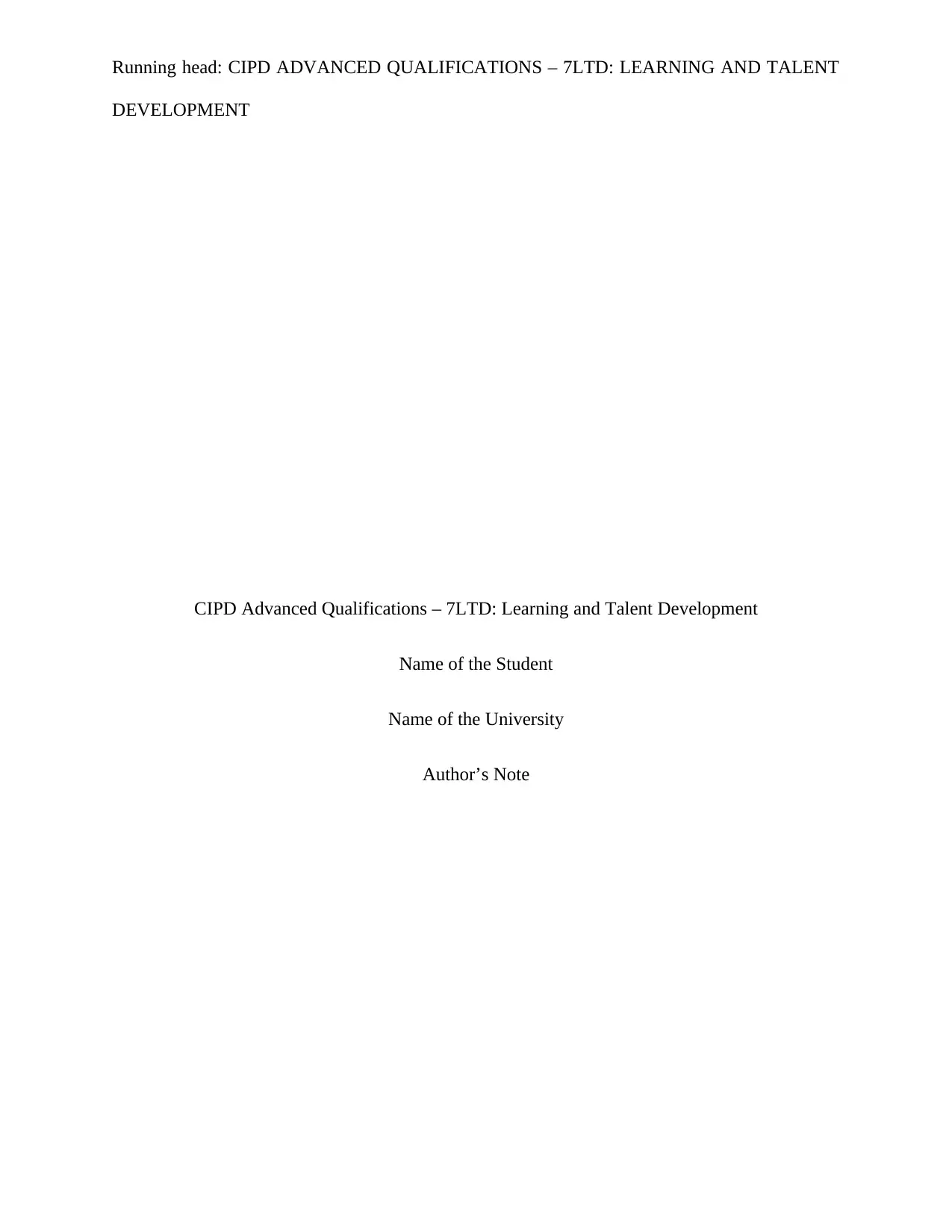
Running head: CIPD ADVANCED QUALIFICATIONS – 7LTD: LEARNING AND TALENT
DEVELOPMENT
CIPD Advanced Qualifications – 7LTD: Learning and Talent Development
Name of the Student
Name of the University
Author’s Note
DEVELOPMENT
CIPD Advanced Qualifications – 7LTD: Learning and Talent Development
Name of the Student
Name of the University
Author’s Note
Paraphrase This Document
Need a fresh take? Get an instant paraphrase of this document with our AI Paraphraser
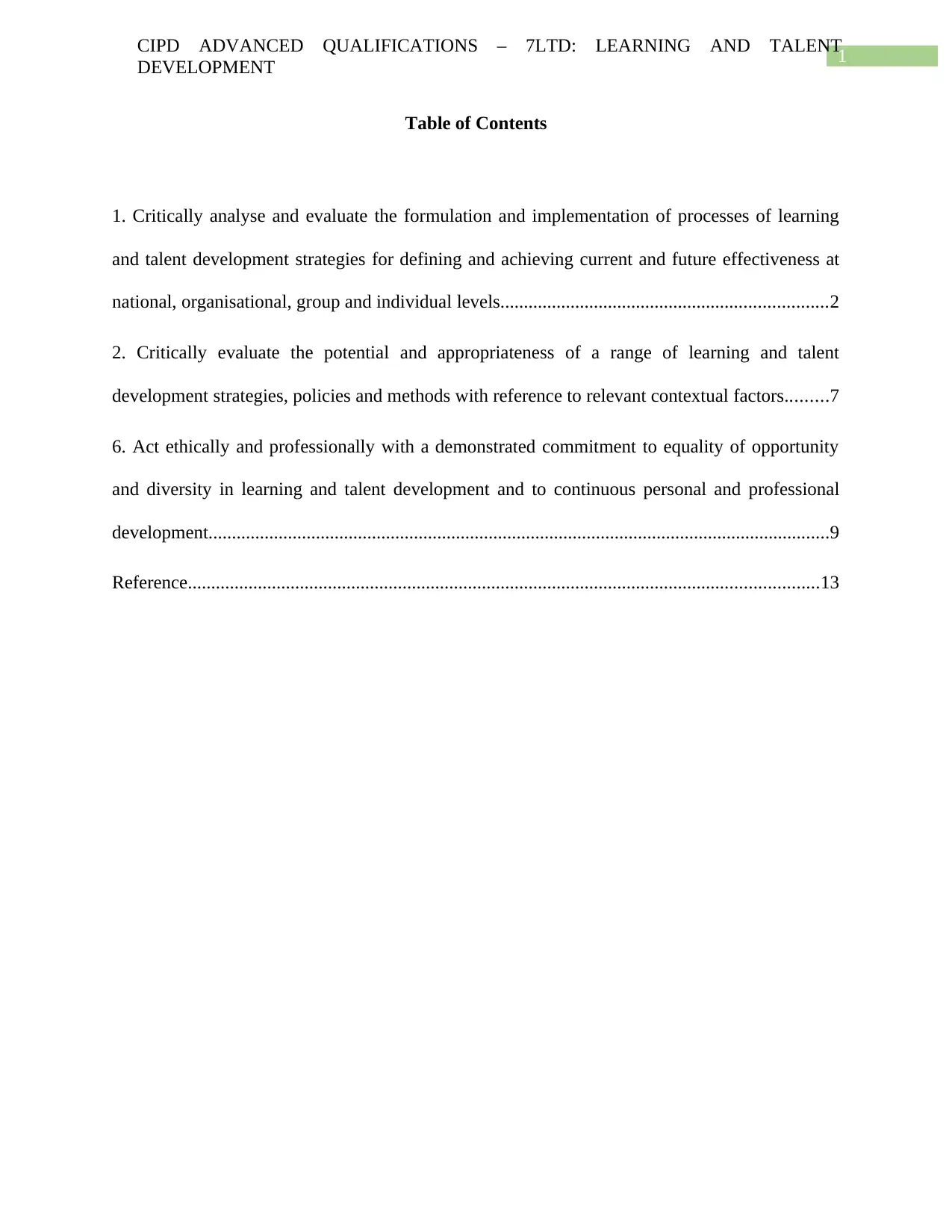
1
CIPD ADVANCED QUALIFICATIONS – 7LTD: LEARNING AND TALENT
DEVELOPMENT
Table of Contents
1. Critically analyse and evaluate the formulation and implementation of processes of learning
and talent development strategies for defining and achieving current and future effectiveness at
national, organisational, group and individual levels......................................................................2
2. Critically evaluate the potential and appropriateness of a range of learning and talent
development strategies, policies and methods with reference to relevant contextual factors.........7
6. Act ethically and professionally with a demonstrated commitment to equality of opportunity
and diversity in learning and talent development and to continuous personal and professional
development.....................................................................................................................................9
Reference.......................................................................................................................................13
CIPD ADVANCED QUALIFICATIONS – 7LTD: LEARNING AND TALENT
DEVELOPMENT
Table of Contents
1. Critically analyse and evaluate the formulation and implementation of processes of learning
and talent development strategies for defining and achieving current and future effectiveness at
national, organisational, group and individual levels......................................................................2
2. Critically evaluate the potential and appropriateness of a range of learning and talent
development strategies, policies and methods with reference to relevant contextual factors.........7
6. Act ethically and professionally with a demonstrated commitment to equality of opportunity
and diversity in learning and talent development and to continuous personal and professional
development.....................................................................................................................................9
Reference.......................................................................................................................................13
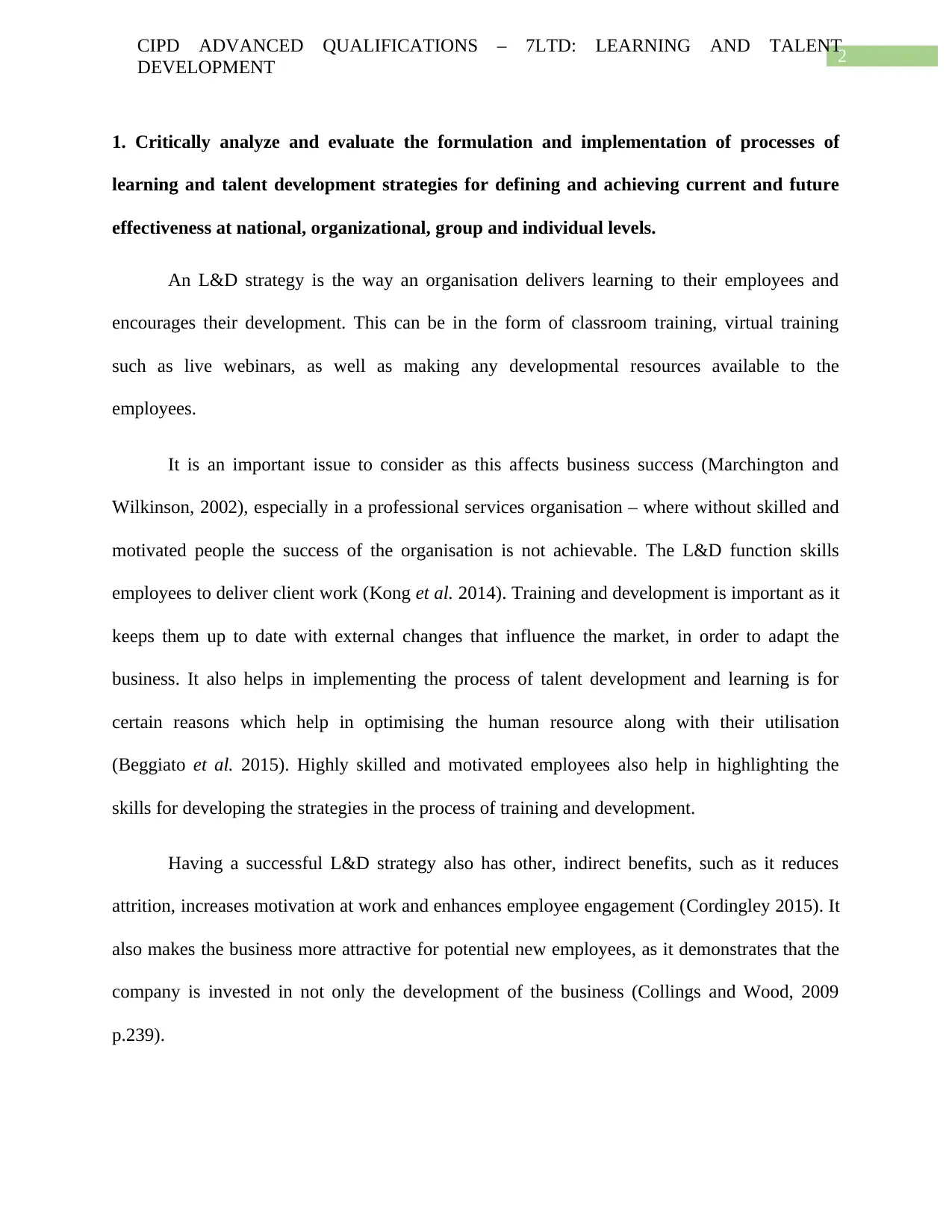
2
CIPD ADVANCED QUALIFICATIONS – 7LTD: LEARNING AND TALENT
DEVELOPMENT
1. Critically analyze and evaluate the formulation and implementation of processes of
learning and talent development strategies for defining and achieving current and future
effectiveness at national, organizational, group and individual levels.
An L&D strategy is the way an organisation delivers learning to their employees and
encourages their development. This can be in the form of classroom training, virtual training
such as live webinars, as well as making any developmental resources available to the
employees.
It is an important issue to consider as this affects business success (Marchington and
Wilkinson, 2002), especially in a professional services organisation – where without skilled and
motivated people the success of the organisation is not achievable. The L&D function skills
employees to deliver client work (Kong et al. 2014). Training and development is important as it
keeps them up to date with external changes that influence the market, in order to adapt the
business. It also helps in implementing the process of talent development and learning is for
certain reasons which help in optimising the human resource along with their utilisation
(Beggiato et al. 2015). Highly skilled and motivated employees also help in highlighting the
skills for developing the strategies in the process of training and development.
Having a successful L&D strategy also has other, indirect benefits, such as it reduces
attrition, increases motivation at work and enhances employee engagement (Cordingley 2015). It
also makes the business more attractive for potential new employees, as it demonstrates that the
company is invested in not only the development of the business (Collings and Wood, 2009
p.239).
CIPD ADVANCED QUALIFICATIONS – 7LTD: LEARNING AND TALENT
DEVELOPMENT
1. Critically analyze and evaluate the formulation and implementation of processes of
learning and talent development strategies for defining and achieving current and future
effectiveness at national, organizational, group and individual levels.
An L&D strategy is the way an organisation delivers learning to their employees and
encourages their development. This can be in the form of classroom training, virtual training
such as live webinars, as well as making any developmental resources available to the
employees.
It is an important issue to consider as this affects business success (Marchington and
Wilkinson, 2002), especially in a professional services organisation – where without skilled and
motivated people the success of the organisation is not achievable. The L&D function skills
employees to deliver client work (Kong et al. 2014). Training and development is important as it
keeps them up to date with external changes that influence the market, in order to adapt the
business. It also helps in implementing the process of talent development and learning is for
certain reasons which help in optimising the human resource along with their utilisation
(Beggiato et al. 2015). Highly skilled and motivated employees also help in highlighting the
skills for developing the strategies in the process of training and development.
Having a successful L&D strategy also has other, indirect benefits, such as it reduces
attrition, increases motivation at work and enhances employee engagement (Cordingley 2015). It
also makes the business more attractive for potential new employees, as it demonstrates that the
company is invested in not only the development of the business (Collings and Wood, 2009
p.239).
⊘ This is a preview!⊘
Do you want full access?
Subscribe today to unlock all pages.

Trusted by 1+ million students worldwide
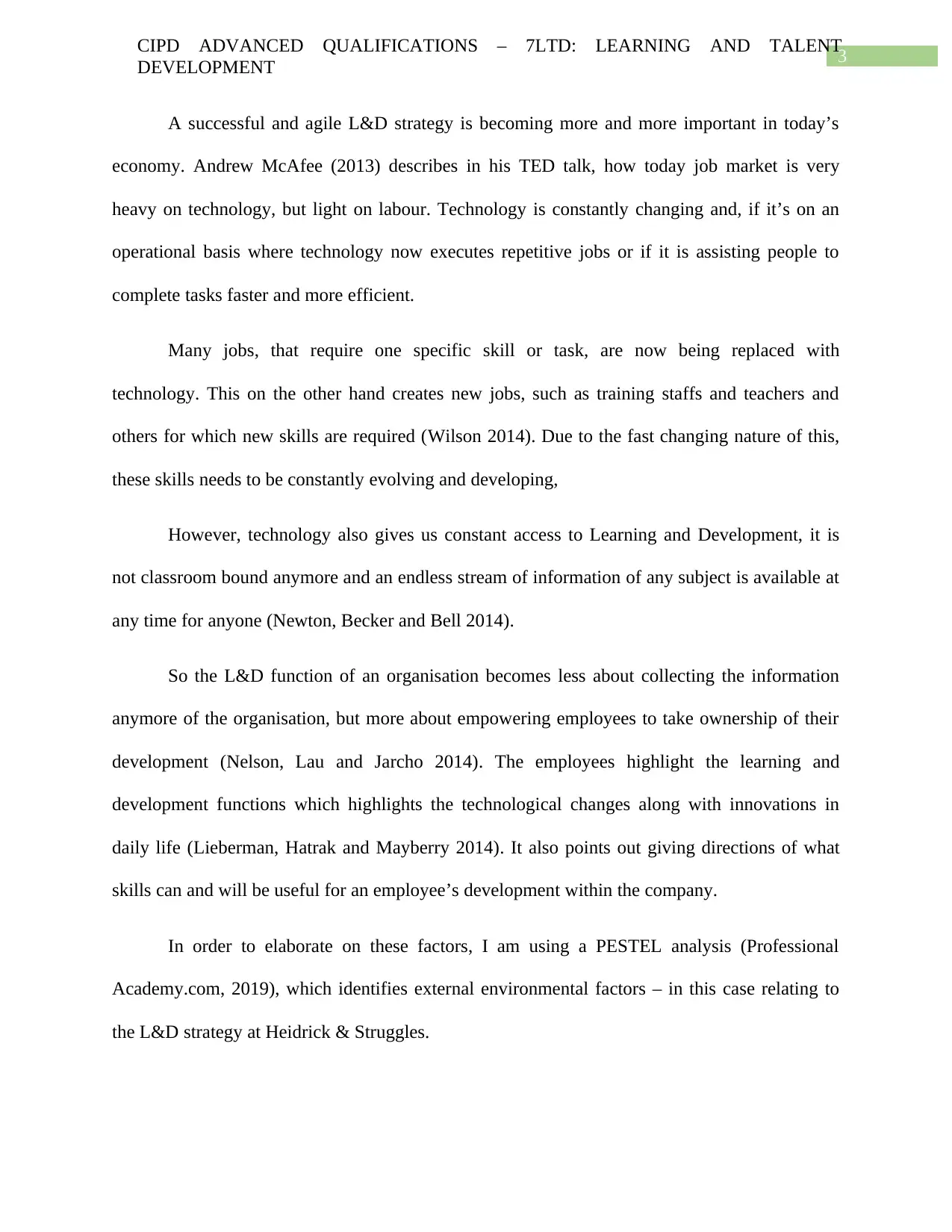
3
CIPD ADVANCED QUALIFICATIONS – 7LTD: LEARNING AND TALENT
DEVELOPMENT
A successful and agile L&D strategy is becoming more and more important in today’s
economy. Andrew McAfee (2013) describes in his TED talk, how today job market is very
heavy on technology, but light on labour. Technology is constantly changing and, if it’s on an
operational basis where technology now executes repetitive jobs or if it is assisting people to
complete tasks faster and more efficient.
Many jobs, that require one specific skill or task, are now being replaced with
technology. This on the other hand creates new jobs, such as training staffs and teachers and
others for which new skills are required (Wilson 2014). Due to the fast changing nature of this,
these skills needs to be constantly evolving and developing,
However, technology also gives us constant access to Learning and Development, it is
not classroom bound anymore and an endless stream of information of any subject is available at
any time for anyone (Newton, Becker and Bell 2014).
So the L&D function of an organisation becomes less about collecting the information
anymore of the organisation, but more about empowering employees to take ownership of their
development (Nelson, Lau and Jarcho 2014). The employees highlight the learning and
development functions which highlights the technological changes along with innovations in
daily life (Lieberman, Hatrak and Mayberry 2014). It also points out giving directions of what
skills can and will be useful for an employee’s development within the company.
In order to elaborate on these factors, I am using a PESTEL analysis (Professional
Academy.com, 2019), which identifies external environmental factors – in this case relating to
the L&D strategy at Heidrick & Struggles.
CIPD ADVANCED QUALIFICATIONS – 7LTD: LEARNING AND TALENT
DEVELOPMENT
A successful and agile L&D strategy is becoming more and more important in today’s
economy. Andrew McAfee (2013) describes in his TED talk, how today job market is very
heavy on technology, but light on labour. Technology is constantly changing and, if it’s on an
operational basis where technology now executes repetitive jobs or if it is assisting people to
complete tasks faster and more efficient.
Many jobs, that require one specific skill or task, are now being replaced with
technology. This on the other hand creates new jobs, such as training staffs and teachers and
others for which new skills are required (Wilson 2014). Due to the fast changing nature of this,
these skills needs to be constantly evolving and developing,
However, technology also gives us constant access to Learning and Development, it is
not classroom bound anymore and an endless stream of information of any subject is available at
any time for anyone (Newton, Becker and Bell 2014).
So the L&D function of an organisation becomes less about collecting the information
anymore of the organisation, but more about empowering employees to take ownership of their
development (Nelson, Lau and Jarcho 2014). The employees highlight the learning and
development functions which highlights the technological changes along with innovations in
daily life (Lieberman, Hatrak and Mayberry 2014). It also points out giving directions of what
skills can and will be useful for an employee’s development within the company.
In order to elaborate on these factors, I am using a PESTEL analysis (Professional
Academy.com, 2019), which identifies external environmental factors – in this case relating to
the L&D strategy at Heidrick & Struggles.
Paraphrase This Document
Need a fresh take? Get an instant paraphrase of this document with our AI Paraphraser
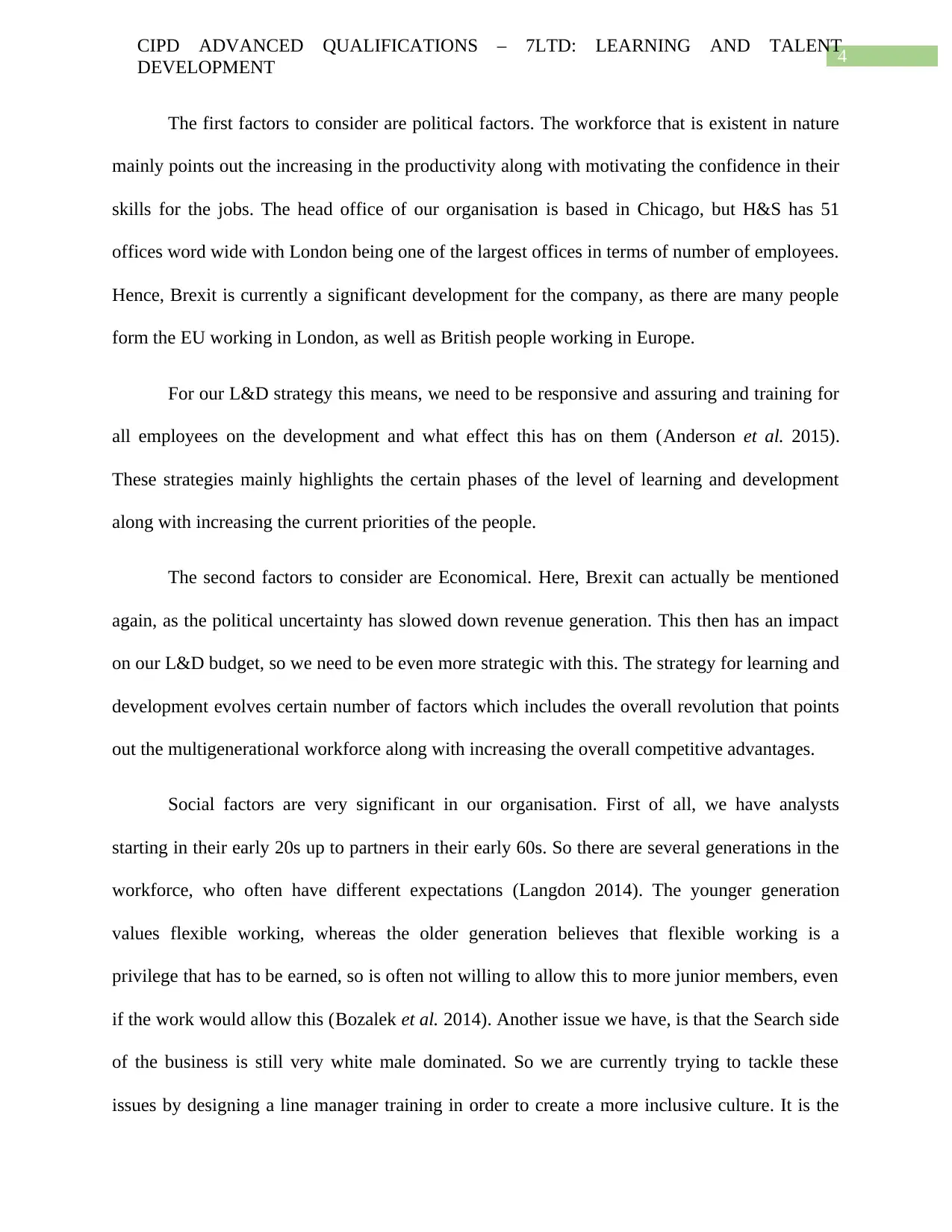
4
CIPD ADVANCED QUALIFICATIONS – 7LTD: LEARNING AND TALENT
DEVELOPMENT
The first factors to consider are political factors. The workforce that is existent in nature
mainly points out the increasing in the productivity along with motivating the confidence in their
skills for the jobs. The head office of our organisation is based in Chicago, but H&S has 51
offices word wide with London being one of the largest offices in terms of number of employees.
Hence, Brexit is currently a significant development for the company, as there are many people
form the EU working in London, as well as British people working in Europe.
For our L&D strategy this means, we need to be responsive and assuring and training for
all employees on the development and what effect this has on them (Anderson et al. 2015).
These strategies mainly highlights the certain phases of the level of learning and development
along with increasing the current priorities of the people.
The second factors to consider are Economical. Here, Brexit can actually be mentioned
again, as the political uncertainty has slowed down revenue generation. This then has an impact
on our L&D budget, so we need to be even more strategic with this. The strategy for learning and
development evolves certain number of factors which includes the overall revolution that points
out the multigenerational workforce along with increasing the overall competitive advantages.
Social factors are very significant in our organisation. First of all, we have analysts
starting in their early 20s up to partners in their early 60s. So there are several generations in the
workforce, who often have different expectations (Langdon 2014). The younger generation
values flexible working, whereas the older generation believes that flexible working is a
privilege that has to be earned, so is often not willing to allow this to more junior members, even
if the work would allow this (Bozalek et al. 2014). Another issue we have, is that the Search side
of the business is still very white male dominated. So we are currently trying to tackle these
issues by designing a line manager training in order to create a more inclusive culture. It is the
CIPD ADVANCED QUALIFICATIONS – 7LTD: LEARNING AND TALENT
DEVELOPMENT
The first factors to consider are political factors. The workforce that is existent in nature
mainly points out the increasing in the productivity along with motivating the confidence in their
skills for the jobs. The head office of our organisation is based in Chicago, but H&S has 51
offices word wide with London being one of the largest offices in terms of number of employees.
Hence, Brexit is currently a significant development for the company, as there are many people
form the EU working in London, as well as British people working in Europe.
For our L&D strategy this means, we need to be responsive and assuring and training for
all employees on the development and what effect this has on them (Anderson et al. 2015).
These strategies mainly highlights the certain phases of the level of learning and development
along with increasing the current priorities of the people.
The second factors to consider are Economical. Here, Brexit can actually be mentioned
again, as the political uncertainty has slowed down revenue generation. This then has an impact
on our L&D budget, so we need to be even more strategic with this. The strategy for learning and
development evolves certain number of factors which includes the overall revolution that points
out the multigenerational workforce along with increasing the overall competitive advantages.
Social factors are very significant in our organisation. First of all, we have analysts
starting in their early 20s up to partners in their early 60s. So there are several generations in the
workforce, who often have different expectations (Langdon 2014). The younger generation
values flexible working, whereas the older generation believes that flexible working is a
privilege that has to be earned, so is often not willing to allow this to more junior members, even
if the work would allow this (Bozalek et al. 2014). Another issue we have, is that the Search side
of the business is still very white male dominated. So we are currently trying to tackle these
issues by designing a line manager training in order to create a more inclusive culture. It is the
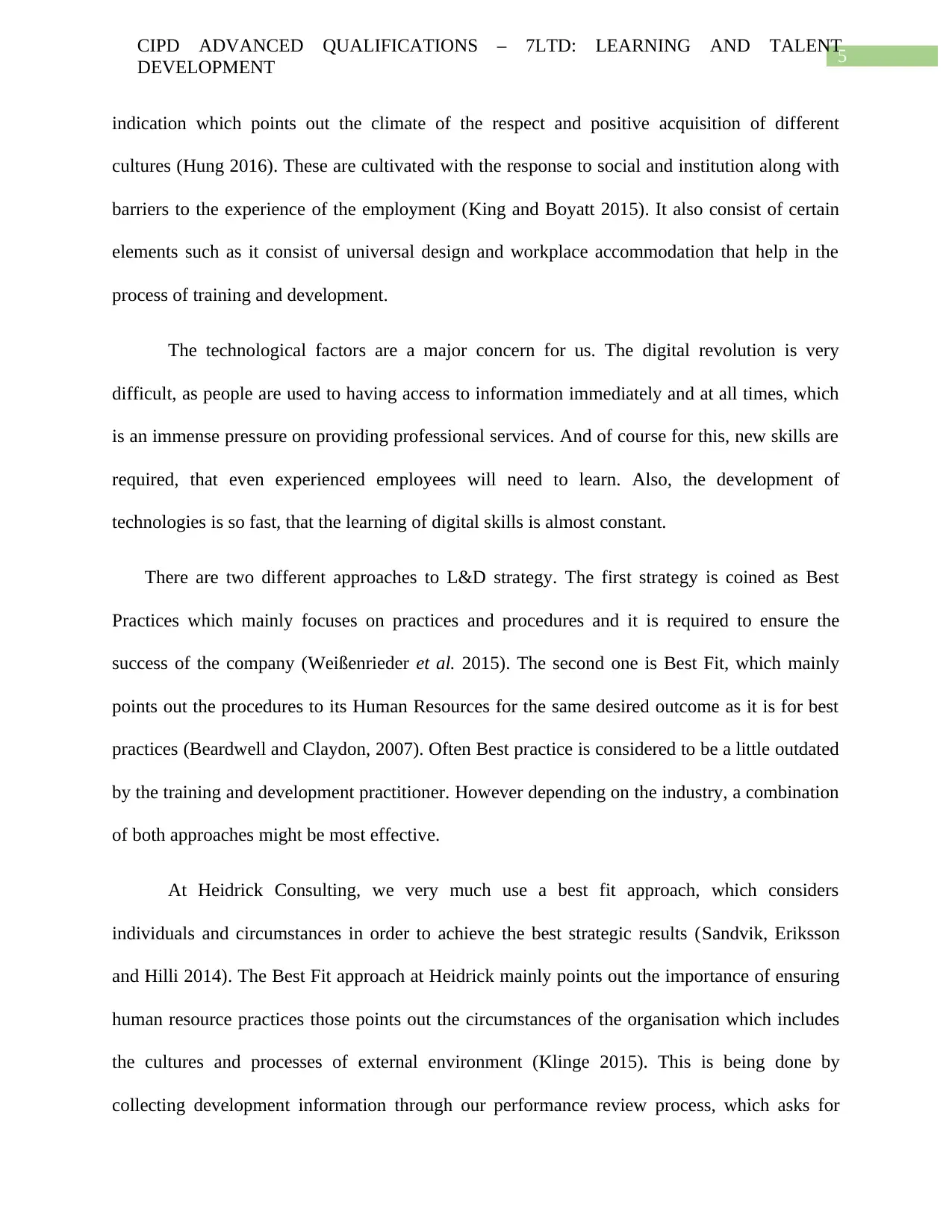
5
CIPD ADVANCED QUALIFICATIONS – 7LTD: LEARNING AND TALENT
DEVELOPMENT
indication which points out the climate of the respect and positive acquisition of different
cultures (Hung 2016). These are cultivated with the response to social and institution along with
barriers to the experience of the employment (King and Boyatt 2015). It also consist of certain
elements such as it consist of universal design and workplace accommodation that help in the
process of training and development.
The technological factors are a major concern for us. The digital revolution is very
difficult, as people are used to having access to information immediately and at all times, which
is an immense pressure on providing professional services. And of course for this, new skills are
required, that even experienced employees will need to learn. Also, the development of
technologies is so fast, that the learning of digital skills is almost constant.
There are two different approaches to L&D strategy. The first strategy is coined as Best
Practices which mainly focuses on practices and procedures and it is required to ensure the
success of the company (Weißenrieder et al. 2015). The second one is Best Fit, which mainly
points out the procedures to its Human Resources for the same desired outcome as it is for best
practices (Beardwell and Claydon, 2007). Often Best practice is considered to be a little outdated
by the training and development practitioner. However depending on the industry, a combination
of both approaches might be most effective.
At Heidrick Consulting, we very much use a best fit approach, which considers
individuals and circumstances in order to achieve the best strategic results (Sandvik, Eriksson
and Hilli 2014). The Best Fit approach at Heidrick mainly points out the importance of ensuring
human resource practices those points out the circumstances of the organisation which includes
the cultures and processes of external environment (Klinge 2015). This is being done by
collecting development information through our performance review process, which asks for
CIPD ADVANCED QUALIFICATIONS – 7LTD: LEARNING AND TALENT
DEVELOPMENT
indication which points out the climate of the respect and positive acquisition of different
cultures (Hung 2016). These are cultivated with the response to social and institution along with
barriers to the experience of the employment (King and Boyatt 2015). It also consist of certain
elements such as it consist of universal design and workplace accommodation that help in the
process of training and development.
The technological factors are a major concern for us. The digital revolution is very
difficult, as people are used to having access to information immediately and at all times, which
is an immense pressure on providing professional services. And of course for this, new skills are
required, that even experienced employees will need to learn. Also, the development of
technologies is so fast, that the learning of digital skills is almost constant.
There are two different approaches to L&D strategy. The first strategy is coined as Best
Practices which mainly focuses on practices and procedures and it is required to ensure the
success of the company (Weißenrieder et al. 2015). The second one is Best Fit, which mainly
points out the procedures to its Human Resources for the same desired outcome as it is for best
practices (Beardwell and Claydon, 2007). Often Best practice is considered to be a little outdated
by the training and development practitioner. However depending on the industry, a combination
of both approaches might be most effective.
At Heidrick Consulting, we very much use a best fit approach, which considers
individuals and circumstances in order to achieve the best strategic results (Sandvik, Eriksson
and Hilli 2014). The Best Fit approach at Heidrick mainly points out the importance of ensuring
human resource practices those points out the circumstances of the organisation which includes
the cultures and processes of external environment (Klinge 2015). This is being done by
collecting development information through our performance review process, which asks for
⊘ This is a preview!⊘
Do you want full access?
Subscribe today to unlock all pages.

Trusted by 1+ million students worldwide
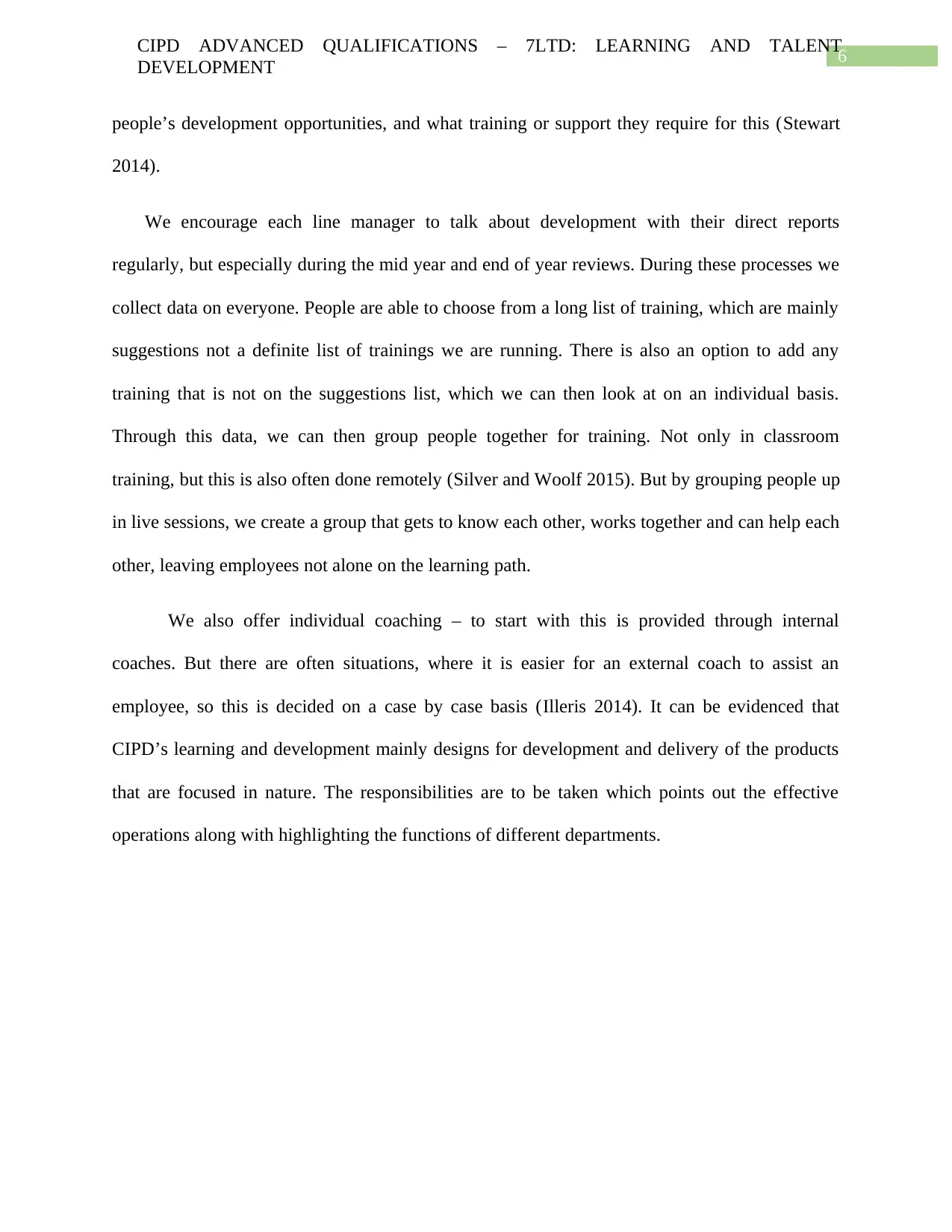
6
CIPD ADVANCED QUALIFICATIONS – 7LTD: LEARNING AND TALENT
DEVELOPMENT
people’s development opportunities, and what training or support they require for this (Stewart
2014).
We encourage each line manager to talk about development with their direct reports
regularly, but especially during the mid year and end of year reviews. During these processes we
collect data on everyone. People are able to choose from a long list of training, which are mainly
suggestions not a definite list of trainings we are running. There is also an option to add any
training that is not on the suggestions list, which we can then look at on an individual basis.
Through this data, we can then group people together for training. Not only in classroom
training, but this is also often done remotely (Silver and Woolf 2015). But by grouping people up
in live sessions, we create a group that gets to know each other, works together and can help each
other, leaving employees not alone on the learning path.
We also offer individual coaching – to start with this is provided through internal
coaches. But there are often situations, where it is easier for an external coach to assist an
employee, so this is decided on a case by case basis (Illeris 2014). It can be evidenced that
CIPD’s learning and development mainly designs for development and delivery of the products
that are focused in nature. The responsibilities are to be taken which points out the effective
operations along with highlighting the functions of different departments.
CIPD ADVANCED QUALIFICATIONS – 7LTD: LEARNING AND TALENT
DEVELOPMENT
people’s development opportunities, and what training or support they require for this (Stewart
2014).
We encourage each line manager to talk about development with their direct reports
regularly, but especially during the mid year and end of year reviews. During these processes we
collect data on everyone. People are able to choose from a long list of training, which are mainly
suggestions not a definite list of trainings we are running. There is also an option to add any
training that is not on the suggestions list, which we can then look at on an individual basis.
Through this data, we can then group people together for training. Not only in classroom
training, but this is also often done remotely (Silver and Woolf 2015). But by grouping people up
in live sessions, we create a group that gets to know each other, works together and can help each
other, leaving employees not alone on the learning path.
We also offer individual coaching – to start with this is provided through internal
coaches. But there are often situations, where it is easier for an external coach to assist an
employee, so this is decided on a case by case basis (Illeris 2014). It can be evidenced that
CIPD’s learning and development mainly designs for development and delivery of the products
that are focused in nature. The responsibilities are to be taken which points out the effective
operations along with highlighting the functions of different departments.
Paraphrase This Document
Need a fresh take? Get an instant paraphrase of this document with our AI Paraphraser
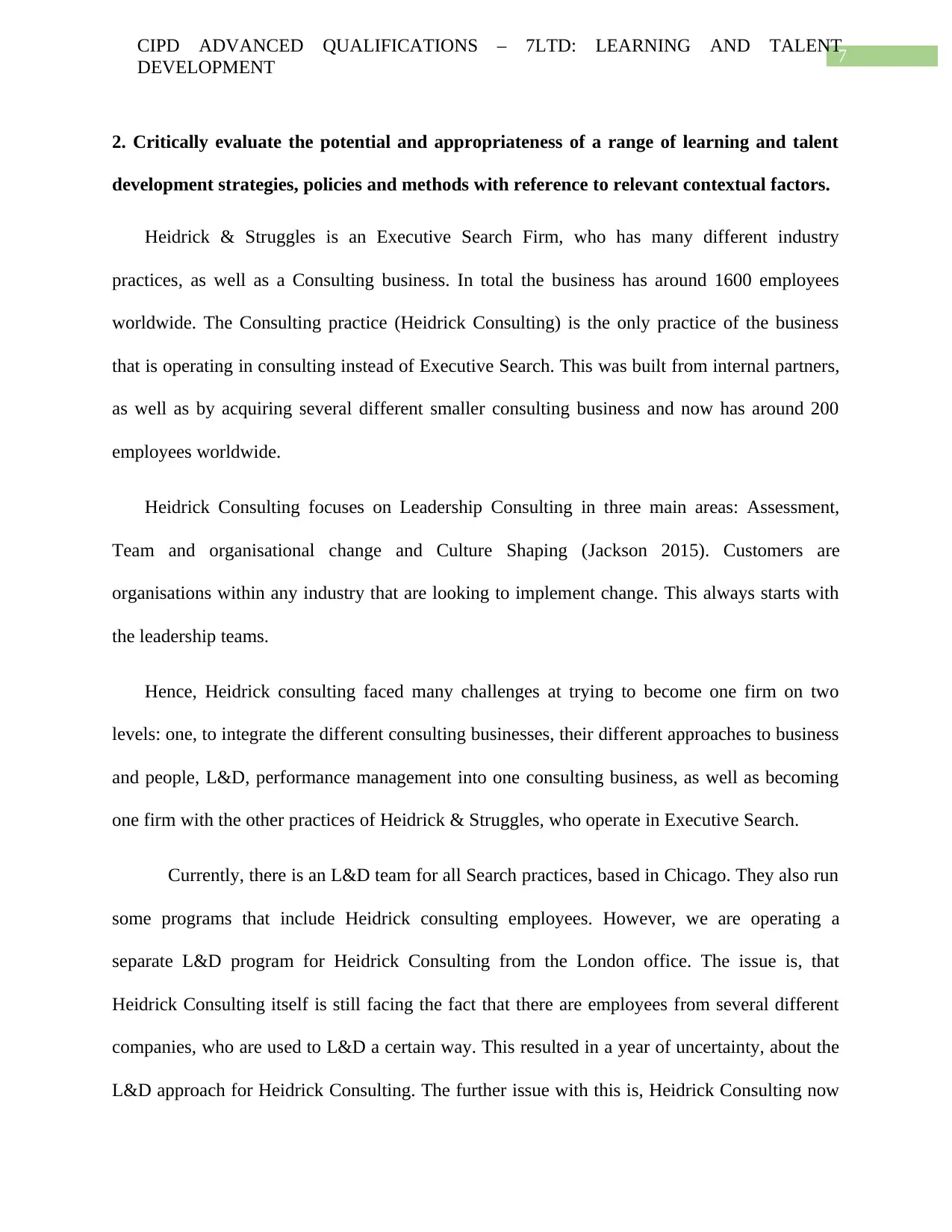
7
CIPD ADVANCED QUALIFICATIONS – 7LTD: LEARNING AND TALENT
DEVELOPMENT
2. Critically evaluate the potential and appropriateness of a range of learning and talent
development strategies, policies and methods with reference to relevant contextual factors.
Heidrick & Struggles is an Executive Search Firm, who has many different industry
practices, as well as a Consulting business. In total the business has around 1600 employees
worldwide. The Consulting practice (Heidrick Consulting) is the only practice of the business
that is operating in consulting instead of Executive Search. This was built from internal partners,
as well as by acquiring several different smaller consulting business and now has around 200
employees worldwide.
Heidrick Consulting focuses on Leadership Consulting in three main areas: Assessment,
Team and organisational change and Culture Shaping (Jackson 2015). Customers are
organisations within any industry that are looking to implement change. This always starts with
the leadership teams.
Hence, Heidrick consulting faced many challenges at trying to become one firm on two
levels: one, to integrate the different consulting businesses, their different approaches to business
and people, L&D, performance management into one consulting business, as well as becoming
one firm with the other practices of Heidrick & Struggles, who operate in Executive Search.
Currently, there is an L&D team for all Search practices, based in Chicago. They also run
some programs that include Heidrick consulting employees. However, we are operating a
separate L&D program for Heidrick Consulting from the London office. The issue is, that
Heidrick Consulting itself is still facing the fact that there are employees from several different
companies, who are used to L&D a certain way. This resulted in a year of uncertainty, about the
L&D approach for Heidrick Consulting. The further issue with this is, Heidrick Consulting now
CIPD ADVANCED QUALIFICATIONS – 7LTD: LEARNING AND TALENT
DEVELOPMENT
2. Critically evaluate the potential and appropriateness of a range of learning and talent
development strategies, policies and methods with reference to relevant contextual factors.
Heidrick & Struggles is an Executive Search Firm, who has many different industry
practices, as well as a Consulting business. In total the business has around 1600 employees
worldwide. The Consulting practice (Heidrick Consulting) is the only practice of the business
that is operating in consulting instead of Executive Search. This was built from internal partners,
as well as by acquiring several different smaller consulting business and now has around 200
employees worldwide.
Heidrick Consulting focuses on Leadership Consulting in three main areas: Assessment,
Team and organisational change and Culture Shaping (Jackson 2015). Customers are
organisations within any industry that are looking to implement change. This always starts with
the leadership teams.
Hence, Heidrick consulting faced many challenges at trying to become one firm on two
levels: one, to integrate the different consulting businesses, their different approaches to business
and people, L&D, performance management into one consulting business, as well as becoming
one firm with the other practices of Heidrick & Struggles, who operate in Executive Search.
Currently, there is an L&D team for all Search practices, based in Chicago. They also run
some programs that include Heidrick consulting employees. However, we are operating a
separate L&D program for Heidrick Consulting from the London office. The issue is, that
Heidrick Consulting itself is still facing the fact that there are employees from several different
companies, who are used to L&D a certain way. This resulted in a year of uncertainty, about the
L&D approach for Heidrick Consulting. The further issue with this is, Heidrick Consulting now
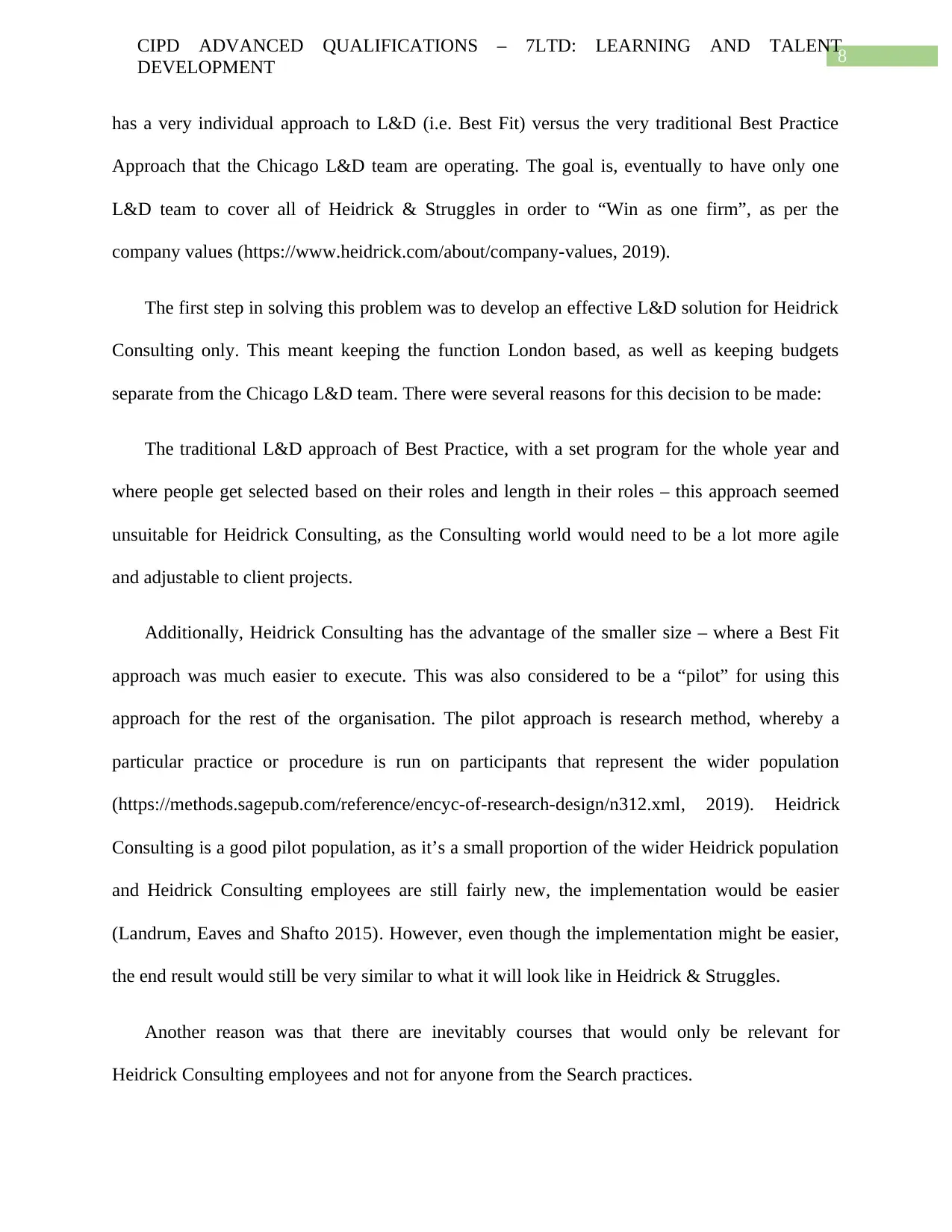
8
CIPD ADVANCED QUALIFICATIONS – 7LTD: LEARNING AND TALENT
DEVELOPMENT
has a very individual approach to L&D (i.e. Best Fit) versus the very traditional Best Practice
Approach that the Chicago L&D team are operating. The goal is, eventually to have only one
L&D team to cover all of Heidrick & Struggles in order to “Win as one firm”, as per the
company values (https://www.heidrick.com/about/company-values, 2019).
The first step in solving this problem was to develop an effective L&D solution for Heidrick
Consulting only. This meant keeping the function London based, as well as keeping budgets
separate from the Chicago L&D team. There were several reasons for this decision to be made:
The traditional L&D approach of Best Practice, with a set program for the whole year and
where people get selected based on their roles and length in their roles – this approach seemed
unsuitable for Heidrick Consulting, as the Consulting world would need to be a lot more agile
and adjustable to client projects.
Additionally, Heidrick Consulting has the advantage of the smaller size – where a Best Fit
approach was much easier to execute. This was also considered to be a “pilot” for using this
approach for the rest of the organisation. The pilot approach is research method, whereby a
particular practice or procedure is run on participants that represent the wider population
(https://methods.sagepub.com/reference/encyc-of-research-design/n312.xml, 2019). Heidrick
Consulting is a good pilot population, as it’s a small proportion of the wider Heidrick population
and Heidrick Consulting employees are still fairly new, the implementation would be easier
(Landrum, Eaves and Shafto 2015). However, even though the implementation might be easier,
the end result would still be very similar to what it will look like in Heidrick & Struggles.
Another reason was that there are inevitably courses that would only be relevant for
Heidrick Consulting employees and not for anyone from the Search practices.
CIPD ADVANCED QUALIFICATIONS – 7LTD: LEARNING AND TALENT
DEVELOPMENT
has a very individual approach to L&D (i.e. Best Fit) versus the very traditional Best Practice
Approach that the Chicago L&D team are operating. The goal is, eventually to have only one
L&D team to cover all of Heidrick & Struggles in order to “Win as one firm”, as per the
company values (https://www.heidrick.com/about/company-values, 2019).
The first step in solving this problem was to develop an effective L&D solution for Heidrick
Consulting only. This meant keeping the function London based, as well as keeping budgets
separate from the Chicago L&D team. There were several reasons for this decision to be made:
The traditional L&D approach of Best Practice, with a set program for the whole year and
where people get selected based on their roles and length in their roles – this approach seemed
unsuitable for Heidrick Consulting, as the Consulting world would need to be a lot more agile
and adjustable to client projects.
Additionally, Heidrick Consulting has the advantage of the smaller size – where a Best Fit
approach was much easier to execute. This was also considered to be a “pilot” for using this
approach for the rest of the organisation. The pilot approach is research method, whereby a
particular practice or procedure is run on participants that represent the wider population
(https://methods.sagepub.com/reference/encyc-of-research-design/n312.xml, 2019). Heidrick
Consulting is a good pilot population, as it’s a small proportion of the wider Heidrick population
and Heidrick Consulting employees are still fairly new, the implementation would be easier
(Landrum, Eaves and Shafto 2015). However, even though the implementation might be easier,
the end result would still be very similar to what it will look like in Heidrick & Struggles.
Another reason was that there are inevitably courses that would only be relevant for
Heidrick Consulting employees and not for anyone from the Search practices.
⊘ This is a preview!⊘
Do you want full access?
Subscribe today to unlock all pages.

Trusted by 1+ million students worldwide
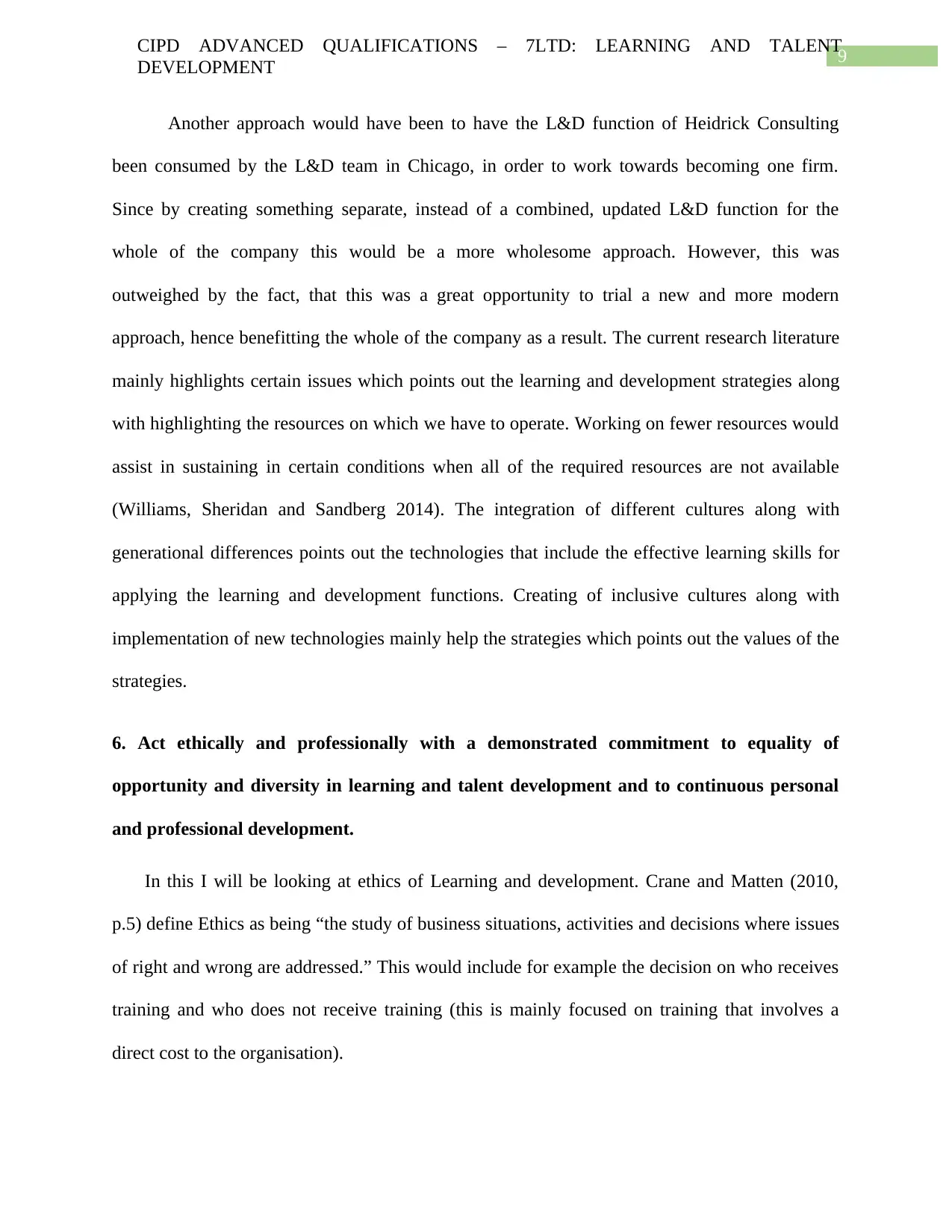
9
CIPD ADVANCED QUALIFICATIONS – 7LTD: LEARNING AND TALENT
DEVELOPMENT
Another approach would have been to have the L&D function of Heidrick Consulting
been consumed by the L&D team in Chicago, in order to work towards becoming one firm.
Since by creating something separate, instead of a combined, updated L&D function for the
whole of the company this would be a more wholesome approach. However, this was
outweighed by the fact, that this was a great opportunity to trial a new and more modern
approach, hence benefitting the whole of the company as a result. The current research literature
mainly highlights certain issues which points out the learning and development strategies along
with highlighting the resources on which we have to operate. Working on fewer resources would
assist in sustaining in certain conditions when all of the required resources are not available
(Williams, Sheridan and Sandberg 2014). The integration of different cultures along with
generational differences points out the technologies that include the effective learning skills for
applying the learning and development functions. Creating of inclusive cultures along with
implementation of new technologies mainly help the strategies which points out the values of the
strategies.
6. Act ethically and professionally with a demonstrated commitment to equality of
opportunity and diversity in learning and talent development and to continuous personal
and professional development.
In this I will be looking at ethics of Learning and development. Crane and Matten (2010,
p.5) define Ethics as being “the study of business situations, activities and decisions where issues
of right and wrong are addressed.” This would include for example the decision on who receives
training and who does not receive training (this is mainly focused on training that involves a
direct cost to the organisation).
CIPD ADVANCED QUALIFICATIONS – 7LTD: LEARNING AND TALENT
DEVELOPMENT
Another approach would have been to have the L&D function of Heidrick Consulting
been consumed by the L&D team in Chicago, in order to work towards becoming one firm.
Since by creating something separate, instead of a combined, updated L&D function for the
whole of the company this would be a more wholesome approach. However, this was
outweighed by the fact, that this was a great opportunity to trial a new and more modern
approach, hence benefitting the whole of the company as a result. The current research literature
mainly highlights certain issues which points out the learning and development strategies along
with highlighting the resources on which we have to operate. Working on fewer resources would
assist in sustaining in certain conditions when all of the required resources are not available
(Williams, Sheridan and Sandberg 2014). The integration of different cultures along with
generational differences points out the technologies that include the effective learning skills for
applying the learning and development functions. Creating of inclusive cultures along with
implementation of new technologies mainly help the strategies which points out the values of the
strategies.
6. Act ethically and professionally with a demonstrated commitment to equality of
opportunity and diversity in learning and talent development and to continuous personal
and professional development.
In this I will be looking at ethics of Learning and development. Crane and Matten (2010,
p.5) define Ethics as being “the study of business situations, activities and decisions where issues
of right and wrong are addressed.” This would include for example the decision on who receives
training and who does not receive training (this is mainly focused on training that involves a
direct cost to the organisation).
Paraphrase This Document
Need a fresh take? Get an instant paraphrase of this document with our AI Paraphraser
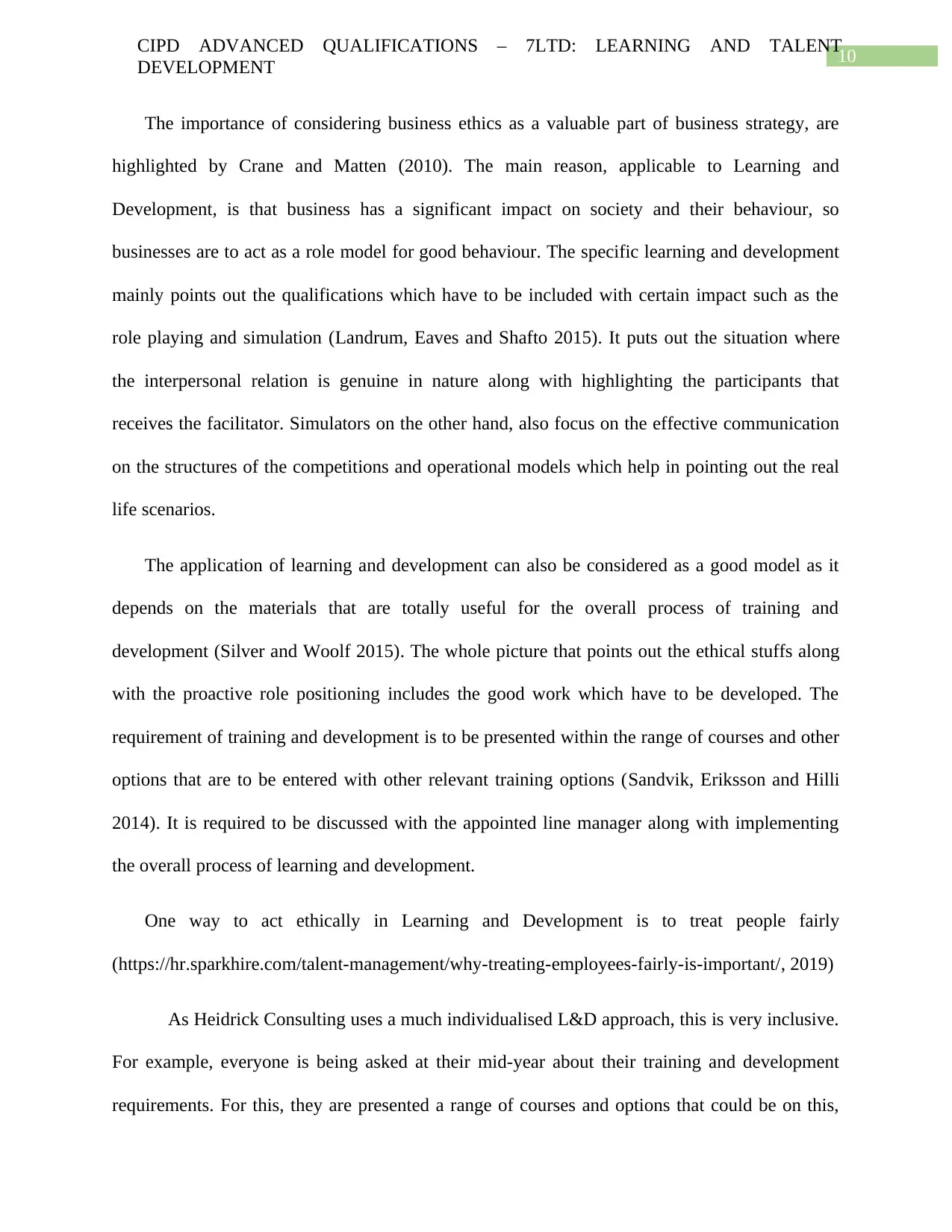
10
CIPD ADVANCED QUALIFICATIONS – 7LTD: LEARNING AND TALENT
DEVELOPMENT
The importance of considering business ethics as a valuable part of business strategy, are
highlighted by Crane and Matten (2010). The main reason, applicable to Learning and
Development, is that business has a significant impact on society and their behaviour, so
businesses are to act as a role model for good behaviour. The specific learning and development
mainly points out the qualifications which have to be included with certain impact such as the
role playing and simulation (Landrum, Eaves and Shafto 2015). It puts out the situation where
the interpersonal relation is genuine in nature along with highlighting the participants that
receives the facilitator. Simulators on the other hand, also focus on the effective communication
on the structures of the competitions and operational models which help in pointing out the real
life scenarios.
The application of learning and development can also be considered as a good model as it
depends on the materials that are totally useful for the overall process of training and
development (Silver and Woolf 2015). The whole picture that points out the ethical stuffs along
with the proactive role positioning includes the good work which have to be developed. The
requirement of training and development is to be presented within the range of courses and other
options that are to be entered with other relevant training options (Sandvik, Eriksson and Hilli
2014). It is required to be discussed with the appointed line manager along with implementing
the overall process of learning and development.
One way to act ethically in Learning and Development is to treat people fairly
(https://hr.sparkhire.com/talent-management/why-treating-employees-fairly-is-important/, 2019)
As Heidrick Consulting uses a much individualised L&D approach, this is very inclusive.
For example, everyone is being asked at their mid-year about their training and development
requirements. For this, they are presented a range of courses and options that could be on this,
CIPD ADVANCED QUALIFICATIONS – 7LTD: LEARNING AND TALENT
DEVELOPMENT
The importance of considering business ethics as a valuable part of business strategy, are
highlighted by Crane and Matten (2010). The main reason, applicable to Learning and
Development, is that business has a significant impact on society and their behaviour, so
businesses are to act as a role model for good behaviour. The specific learning and development
mainly points out the qualifications which have to be included with certain impact such as the
role playing and simulation (Landrum, Eaves and Shafto 2015). It puts out the situation where
the interpersonal relation is genuine in nature along with highlighting the participants that
receives the facilitator. Simulators on the other hand, also focus on the effective communication
on the structures of the competitions and operational models which help in pointing out the real
life scenarios.
The application of learning and development can also be considered as a good model as it
depends on the materials that are totally useful for the overall process of training and
development (Silver and Woolf 2015). The whole picture that points out the ethical stuffs along
with the proactive role positioning includes the good work which have to be developed. The
requirement of training and development is to be presented within the range of courses and other
options that are to be entered with other relevant training options (Sandvik, Eriksson and Hilli
2014). It is required to be discussed with the appointed line manager along with implementing
the overall process of learning and development.
One way to act ethically in Learning and Development is to treat people fairly
(https://hr.sparkhire.com/talent-management/why-treating-employees-fairly-is-important/, 2019)
As Heidrick Consulting uses a much individualised L&D approach, this is very inclusive.
For example, everyone is being asked at their mid-year about their training and development
requirements. For this, they are presented a range of courses and options that could be on this,
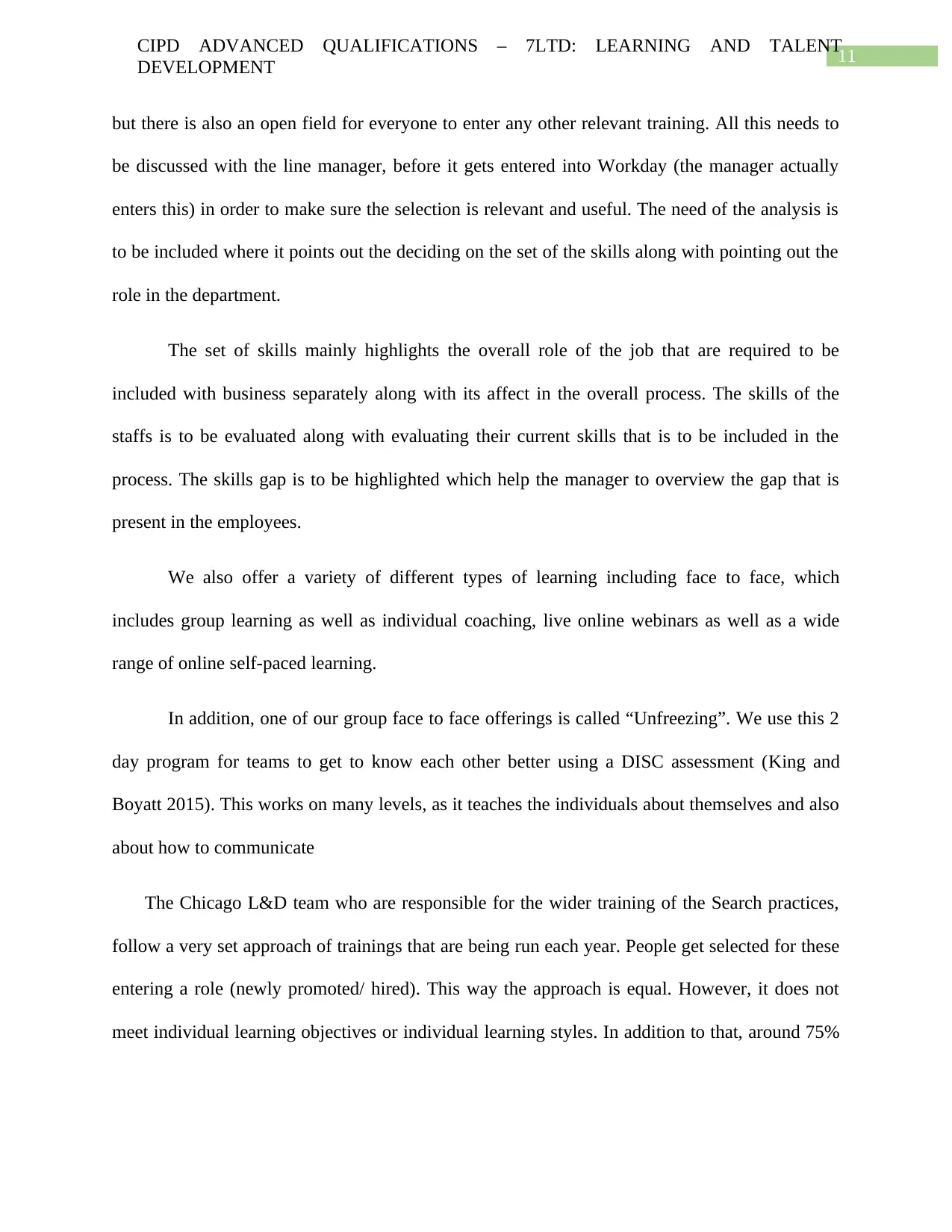
11
CIPD ADVANCED QUALIFICATIONS – 7LTD: LEARNING AND TALENT
DEVELOPMENT
but there is also an open field for everyone to enter any other relevant training. All this needs to
be discussed with the line manager, before it gets entered into Workday (the manager actually
enters this) in order to make sure the selection is relevant and useful. The need of the analysis is
to be included where it points out the deciding on the set of the skills along with pointing out the
role in the department.
The set of skills mainly highlights the overall role of the job that are required to be
included with business separately along with its affect in the overall process. The skills of the
staffs is to be evaluated along with evaluating their current skills that is to be included in the
process. The skills gap is to be highlighted which help the manager to overview the gap that is
present in the employees.
We also offer a variety of different types of learning including face to face, which
includes group learning as well as individual coaching, live online webinars as well as a wide
range of online self-paced learning.
In addition, one of our group face to face offerings is called “Unfreezing”. We use this 2
day program for teams to get to know each other better using a DISC assessment (King and
Boyatt 2015). This works on many levels, as it teaches the individuals about themselves and also
about how to communicate
The Chicago L&D team who are responsible for the wider training of the Search practices,
follow a very set approach of trainings that are being run each year. People get selected for these
entering a role (newly promoted/ hired). This way the approach is equal. However, it does not
meet individual learning objectives or individual learning styles. In addition to that, around 75%
CIPD ADVANCED QUALIFICATIONS – 7LTD: LEARNING AND TALENT
DEVELOPMENT
but there is also an open field for everyone to enter any other relevant training. All this needs to
be discussed with the line manager, before it gets entered into Workday (the manager actually
enters this) in order to make sure the selection is relevant and useful. The need of the analysis is
to be included where it points out the deciding on the set of the skills along with pointing out the
role in the department.
The set of skills mainly highlights the overall role of the job that are required to be
included with business separately along with its affect in the overall process. The skills of the
staffs is to be evaluated along with evaluating their current skills that is to be included in the
process. The skills gap is to be highlighted which help the manager to overview the gap that is
present in the employees.
We also offer a variety of different types of learning including face to face, which
includes group learning as well as individual coaching, live online webinars as well as a wide
range of online self-paced learning.
In addition, one of our group face to face offerings is called “Unfreezing”. We use this 2
day program for teams to get to know each other better using a DISC assessment (King and
Boyatt 2015). This works on many levels, as it teaches the individuals about themselves and also
about how to communicate
The Chicago L&D team who are responsible for the wider training of the Search practices,
follow a very set approach of trainings that are being run each year. People get selected for these
entering a role (newly promoted/ hired). This way the approach is equal. However, it does not
meet individual learning objectives or individual learning styles. In addition to that, around 75%
⊘ This is a preview!⊘
Do you want full access?
Subscribe today to unlock all pages.

Trusted by 1+ million students worldwide
1 out of 16
Related Documents
Your All-in-One AI-Powered Toolkit for Academic Success.
+13062052269
info@desklib.com
Available 24*7 on WhatsApp / Email
![[object Object]](/_next/static/media/star-bottom.7253800d.svg)
Unlock your academic potential
Copyright © 2020–2025 A2Z Services. All Rights Reserved. Developed and managed by ZUCOL.





